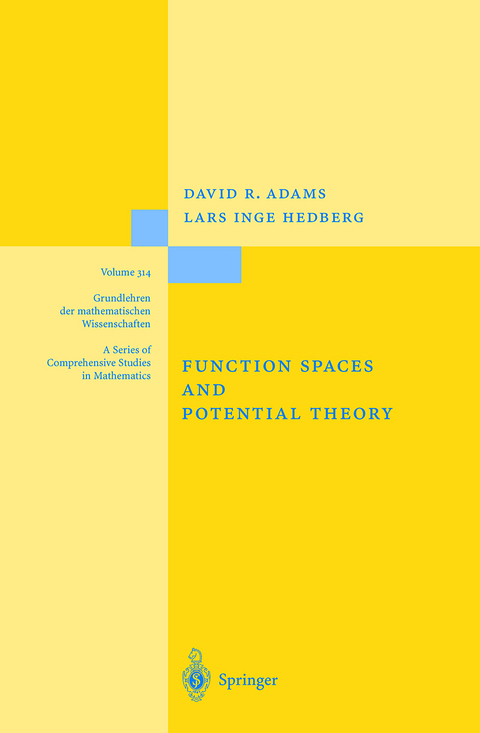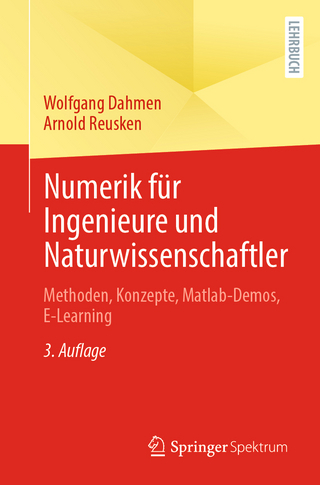
Function Spaces and Potential Theory
Springer Berlin (Verlag)
978-3-540-57060-8 (ISBN)
1. Preliminaries.- 1.1 Basics.- 1.2 Sobolev Spaces and Bessel Potentials.- 1.3 Banach Spaces.- 1.4 Two Covering Lemmas.- 2. Lp-Capacities and Nonlinear Potentials.- 2.1 Introduction.- 2.2 A First Version of (?, p)-Capacity.- 2.3 A General Theory for LP-Capacities.- 2.4 The Minimax Theorem.- 2.5 The Dual Definition of Capacity.- 2.6 Radially Decreasing Convolution Kernels.- 2.7 An Alternative Definition of Capacity and Removability of Singularities.- 2.8 Further Results.- 2.9 Notes.- 3. Estimates for Bessel and Riesz Potentials.- 3.1 Pointwise and Integral Estimates.- 3.2 A Sharp Exponential Estimate.- 3.3 Operations on Potentials.- 3.4 One-Sided Approximation.- 3.5 Operations on Potentials with Fractional Index.- 3.6 Potentials and Maximal Functions.- 3.7 Further Results.- 3.8 Notes.- 4. Besov Spaces and Lizorkin-Triebel Spaces.- 4.1 Besov Spaces.- 4.2 Lizorkin-Triebel Spaces.- 4.3 Lizorkin-Triebel Spaces, Continued.- 4.4 More Nonlinear Potentials.- 4.5 An Inequality of Wolff.- 4.6 An Atomic Decomposition.- 4.7 Atomic Nonlinear Potentials.- 4.8 A Characterization of L?,P.- 4.9 Notes.- 5. Metric Properties of Capacities.- 5.1 Comparison Theorems.- 5.2 Lipschitz Mappings and Capacities.- 5.3 The Capacity of Cantor Sets.- 5.4 Sharpness of Comparison Theorems.- 5.5 Relations Between Different Capacities.- 5.6 Further Results.- 5.7 Notes.- 6. Continuity Properties.- 6.1 Quasicontinuity.- 6.2 Lebesgue Points.- 6.3 Thin Sets.- 6.4 Fine Continuity.- 6.5 Further Results.- 6.6 Notes.- 7. Trace and Imbedding Theorems.- 7.1 A Capacitary Strong Type Inequality.- 7.2 Imbedding of Potentials.- 7.3 Compactness of the Imbedding.- 7.4 A Space of Quasicontinuous Functions.- 7.5 A Capacitary Strong Type Inequality. Another Approach.- 7.6 Further Results.- 7.7 Notes.- 8. Poincaré TypeInequalities.- 8.1 Some Basic Inequalities.- 8.2 Inequalities Depending on Capacities.- 8.3 An Abstract Approach.- 8.4 Notes.- 9. An Approximation Theorem.- 9.1 Statement of Results.- 9.2 The Case m = 1.- 9.3 The General Case. Outline.- 9.4 The Uniformly (1, p)-Thick Case.- 9.5 The General Thick Case.- 9.6 Proof of Lemma 9.5.2 for m = 1.- 9.7 Proof of Lemma 9.5.2.- 9.8 Estimates for Nonlinear Potentials.- 9.9 The Case Cm p(K) = 0.- 9.10 The Case Ck,p(K) = 0, 1 ? k < m.- 9.11 Conclusion of the Proof.- 9.12 Further Results.- 9.13 Notes.- 10. Two Theorems of Netrusov.- 10.1 An Approximation Theorem, Another Approach.- 10.2 A Generalization of a Theorem of Whitney.- 10.3 Further Results.- 10.4 Notes.- 11. Rational and Harmonic Approximation.- 11.1 Approximation and Stability.- 11.2 Approximation by Harmonic Functions in Gradient Norm.- 11.3 Stability of Sets Without Interior.- 11.4 Stability of Sets with Interior.- 11.5 Approximation by Harmonic Functions and Higher Order Stability.- 11.6 Further Results.- 11.7 Notes.- References.- List of Symbols.
"..carefully and thoughtfully written and prepared with, in my opinion, just the right amount of detail included...will certainly be a primary source that I shall turn to." Proceedings of the Edinburgh Mathematical Society
"..carefully and thoughtfully written and prepared with, in my opinion, just the right amount of detail included...will certainly be a primary source that I shall turn to." Proceedings of the Edinburgh Mathematical Society
| Erscheint lt. Verlag | 17.11.1995 |
|---|---|
| Reihe/Serie | Grundlehren der mathematischen Wissenschaften |
| Zusatzinfo | XI, 368 p. |
| Verlagsort | Berlin |
| Sprache | englisch |
| Maße | 155 x 235 mm |
| Gewicht | 692 g |
| Themenwelt | Mathematik / Informatik ► Mathematik ► Analysis |
| Mathematik / Informatik ► Mathematik ► Wahrscheinlichkeit / Kombinatorik | |
| Schlagworte | Approximation Theory • Capacity • convolution • Distribution • Fourier transform • function spaces • Funktion (Mathematik) • hilbert space • Potentialtheorie • Potential Theory • Singular integral |
| ISBN-10 | 3-540-57060-8 / 3540570608 |
| ISBN-13 | 978-3-540-57060-8 / 9783540570608 |
| Zustand | Neuware |
| Haben Sie eine Frage zum Produkt? |
aus dem Bereich


